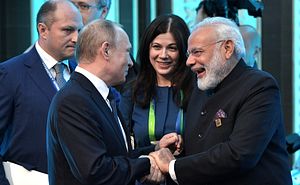On October 5, Russian President Vladimir Putin is to hold the India-Russia annual summit meeting with Indian Prime Minister Narendra Modi in New Delhi. The last summit meeting took place in St. Petersburg in 2017, and Putin and Modi met last for an informal summit in Sochi in May this year.
The summit process between India and Russia started way back in 2000 and since then, the relationship has been elevated to a “Special and Privileged Strategic Partnership.” The India-Russia strategic partnership is important for a number of reasons, but the two countries also face significant challenges. The relationship in the last few years have undergone some big changes, not all of them positive. The key question therefore is to see if the age-old bilateral relationship is sturdy enough to withstand some of the current turbulence.
As Putin arrives in New Delhi, there is both excitement and uneasiness around the visit and what might come of it. There is excitement on both sides about a couple of important defense deals and there are plans to strengthen and streamline civil nuclear cooperation between the two countries. But there is also anxiety in New Delhi about the growing Russia-China ties and what that could mean for India.
On the other hand, Moscow remains anxious about India’s changing strategic orientation, particularly its relationship with the United States, and New Delhi’s defense trade diversification policy, among other issues. Russia has failed to appreciate the Indian strategic calculation behind its closer strategic engagement with the United States and other partners such as Japan and Australia.
From India’s perspective, Russia remains an important strategic partner for a number of different reasons. The historical character of the bilateral relationship aside, there are several strategic factors that impinge on the Russia-India dynamic. For one, Russia remains the only partner that is still willing to give India critical technologies, such as a nuclear submarine. Two, the emerging Russia-China strategic relationship has important security consequences for India. Even as India is diversifying its defense trade partners, Russia still dominates the Indian defense inventory to the tune of about 70 per cent. This raises worries in India because of the changing nature of the Russia-China defense relationship.
To take just one example, Russia’s sale of Su-30 and especially the Su-35 fighter puts India’s security at some risk. Russia’s sale of advanced Kilo-class submarines is another instance. These are illustrations of the important changes in the Russia-China security dynamics because Beijing for a long time was not given access to the best and most modern Russian technology and there was no technology transfer. The Russia-China oil and gas deals over the last few years also is a testament to this new closer partnership.
On the other hand, there are positive elements also in India-Russia relationship. Civil nuclear cooperation and defense and technology collaboration will dominate the Putin-Modi Summit meeting. The two sides are believed to be formalizing an action plan on nuclear cooperation. The two sides are also expected to sign an agreement for the purchase of the advanced S-400 Triumf air defense systems worth more than $5 billion.
This deal has been under threat because of the US’ CAATSA (Countering America’s Adversaries Through Sanctions Act) legislation, which seeks to sanction any country that does significant business with Russia in the defense or intelligence domains. Even though U.S. Defense Secretary James Mattis has sought an exemption for India, and the U.S. Congress has given the U.S. administration the authority to waive CAATSA, it is up to the president to decide on whether such a waiver will be granted.
Irrespective of how the CAATSA sanctions may play out, India appears quite certain that it wants the S-400 because of the technological superiority of the system. India has explored a financial mechanism where India can make the payment in rupees rather than in U.S. dollars. Though the United States has not indicated how it will react to the S-400 deal, Washington has been somewhat understanding because India over the last few years has diversified its defense procurement and reduced its dependency on Russia to some extent, which is one of the conditions for gaining a CAATSA waiver.
Russia, for its part, appears quite confident that the deal will go through. Igor Korotchenko, head of the Moscow-based Centre for Analysis of World Arms Trade noted that “the U.S. won’t impose sanctions on them because they don’t want the Indians to refuse to purchase American weapons in the future.”
There are reports suggesting that there may be an agreement also for the sale of four frigates to India. Under the deal, two of the advanced Talwar-class frigates will be directly purchased from Russia’s Yantar Shipyard and delivered in two years’ time, while the next two will be built at the Goa Shipyard. Although of an earlier previous generation, the Indian Navy already operates six of the Talwar-class frigates. Defense analysts add that the newer frigates will be equipped with the Brahmos missiles.
There is also the possibility of Russia-India cooperation on Amur-class submarine. Andrei I Baranov, Deputy Director General for Foreign Activities at Rubin Design Bureau which builds these submarines, promised that India will be able to have 80 percent indigenization. The potential for collaboration to jointly develop Air Independent Propulsion (AIP) is also a possibility.
Such defense deals and nuclear energy cooperation should keep the India-Russia relationship afloat for the time being. But they will not assuage New Delhi’s long terms concerns about the increasingly close Russia-China strategic partnership.
































